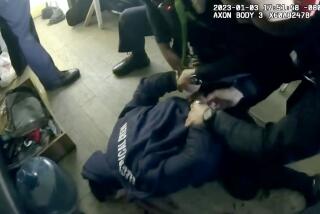L.A. Police Commission approves proposals to increase transparency, training for how LAPD officers use force

The Los Angeles Police Commission will consider significant changes in the way the LAPD handles shootings.
The Los Angeles Police Commission told the LAPD on Tuesday to share more information with the public about shootings by officers, describing increased transparency as vital to building trust after fatal police shootings in the city and across the country.
The unanimous vote reflects a nationwide atmosphere of heightened scrutiny of police use of force and demands for greater openness about why officers fire their guns. In Los Angeles recently, there have been demonstrations at shooting scenes, a month-long sit-in outside City Hall and noisy protests at the Police Commission’s weekly meetings.
“After a shooting occurs, there are often questions from the community — and rightfully so — about what happened and whether the shooting was necessary,” said Commissioner Sandra Figueroa-Villa, the executive director of a nonprofit community group. “I believe transparency is vitally important in addressing those concerns.”
The plan to increase transparency was among a series of proposals adopted by the civilian board, inspired by an extensive analysis by the commission’s inspector general that found that some other major law enforcement departments more quickly provide the public additional information about police shootings and give officers more training based on real-world scenarios.
The Police Commission voted to require the LAPD to expand its real-world, role-playing training for officers, ensure that police who fire their guns receive more support and collect feedback from residents on whether video from police shootings should become public. Commissioners also directed Inspector General Alex Bustamante to increase the number of staff who review how officers use less serious force, such as less-lethal weapons or punches, to take someone into custody. Those types of encounters attract less public attention but occur far more often than shootings and other serious force.
The actions are part of the commission’s ongoing effort to examine how LAPD officers use force in hopes of reducing the number of police shootings.
The union representing rank-and-file officers accused the commission of avoiding more pressing issues facing the LAPD — such as keeping an adequate number of officers working in patrol or reducing the ongoing uptick in violent crime — and instead folding to pressure from police critics.
“The commission has become nothing more than a group of pandering apologists in support of misinformed professional protesters,” the union’s board of directors said in a statement. “These latest batch of proposals are more of the same, solutions in search of a problem.”
But LAPD brass signaled their support for the commission’s directives. They noted that the department was already reviewing training and revising its policies to specifically require that officers, when possible, try to defuse tense encounters before firing their guns. The policy changes were ordered by the commission earlier this year.
“It’s important to reach out, it’s important to realize that not everything is invented here, and it’s important to look into other agencies’ experiences so that we can make this the best police department it can possibly be,” Chief Charlie Beck said. “All of these things are worth considering.”
The inspector general’s report, 11 months in the works, looked at how police in L.A., Dallas, Las Vegas, Washington D.C., and San Diego treat officers who fire their weapons, emphasize ways officers can try to avoid using force, and share information — including video of deadly encounters — with the public.
In Las Vegas, police quickly post short video statements about shootings on YouTube and, within the week, give reporters an in-depth briefing that includes what happened in the moments before the shooting, photographs from the scene, 911 calls and any video collected. Beck said he liked that a “totality of the investigation” was made public during that briefing, though he questioned whether the LAPD would release the information within the same time frame.
His department generally releases limited information soon after shootings, including the names of officers, but waits to provide a more detailed report about what happened until it finishes an internal investigation and presents its findings to the Police Commission. That process can take nearly a year.
Even then, the reports made public are heavily redacted to remove the names of officers. Videos of shootings are generally not released.
Beck said he believes the LAPD releases “a lot of information.”
“It just has never been on the time frame that suited everybody,” he said.
Law enforcement agencies in San Diego County recently agreed to new rules for releasing video from police shootings, including those collected from body cameras. There, the district attorney shares the video with the public after deciding whether or not to file charges against the officers. If charges are filed, the video would remain confidential until presented in court.
Beck has generally declined to release the videos outside of court, citing concerns over victim privacy and the need to protect investigations. But he, like police chiefs across the country, have been forced to rethink that stance as the intense public scrutiny over policing has flared over controversial shootings by officers.
Last week, Beck released a security video showing Carnell Snell Jr. holding a gun in the moments before he was fatally shot by police in South L.A. The chief said he decided to share the video out of concern for public safety and to clear up what he described as “significant misinformation” about the deadly encounter.
Any healthy organization must pause every now and again to do some self-examination.
— Matt Johnson
On Tuesday, Beck said officials were trying to find the right time to make videos public by balancing the public’s interest with the need to avoid tarnishing potential witnesses by prematurely releasing information.
Cameras, he said, presented a “rapidly changing technology” in policing. “It would be silly to fall back on some of the things that we’ve always done.”
The commission directed the department to begin a “comprehensive process” for gathering feedback on the LAPD’s policy for releasing video that includes community forums, online questionnaires and focus groups. A draft policy will then be posted online for 30 days to collect additional feedback.
Peter Bibring, an attorney for the ACLU of Southern California, said he believes departments should follow Las Vegas’ example and release videos of police shootings or other incidents in which officers are accused of misconduct within days, not months. The same goes for other information about shootings by officers, he said.
“It’s one thing to ask the public for patience to wait for information that’s going to take months or years to arrive — if it comes at all,” Bibring said. “It’s another thing to ask them to wait a week, when they’re going to be assured that at the end of that time they will get a complete account of what the department knows and video evidence.”
The discussion at Tuesday’s commission meeting also focused on the training officers receive and the psychological help they are offered after they fire their guns. The commission directed the LAPD to increase that support, find ways to keep officers informed about ongoing investigations and reviews of shootings, and give officers “reality-based” training before they return to the field.
Interested in the stories shaping California? Sign up for the free Essential California newsletter »
Law enforcement agencies are increasingly turning to role-playing training to provide officers with a realistic simulation of stressful encounters — often involving people who appear to be mentally ill or suicidal — that can result in shootings or other serious force. The goal is for officers to practice de-escalating those moments so that it comes more naturally in the field.
The LAPD offers some reality-based training, according to the inspector general’s report, but other agencies use it more frequently. Police commissioners told the LAPD to look for ways to regularly provide officers with that training.
“Any healthy organization must pause every now and again to do some self-examination and make sure it’s using the best and most current methods,” said Matt Johnson, the board’s president. “I know that LAPD is not afraid to look in the mirror.”
Follow me on Twitter: @katemather
ALSO
How ‘MASH’ actor Mike Farrell became a leading voice against the death penalty in California
See what’s killing haunted houses and other independent Halloween attractions
Two people shot, another hurt amid chaos outside Signal Hill strip club
UPDATES:
8:25 p.m.: This article was updated with comments from Bibring, Johnson and Beck as well as more details about Tuesday’s vote.
1:10 p.m.: This article was updated with the vote as well as quotes from LAPD Chief Charlie Beck and Sandra Figueroa-Villa a commissioner on the Los Angeles Police Commission.
This article was originally published at 9:45 a.m.
More to Read
Start your day right
Sign up for Essential California for news, features and recommendations from the L.A. Times and beyond in your inbox six days a week.
You may occasionally receive promotional content from the Los Angeles Times.







